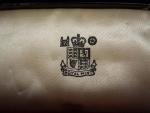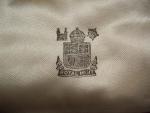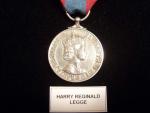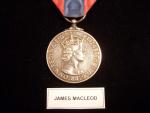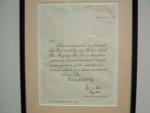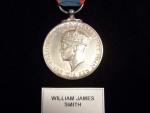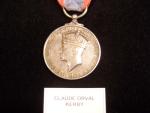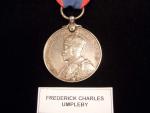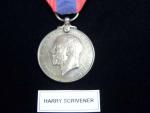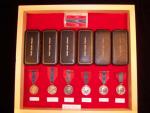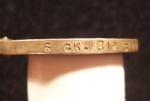-
Posts
6,486 -
Joined
-
Last visited
-
Days Won
10
Content Type
Profiles
Forums
Blogs
Gallery
Events
Store
Everything posted by Brian Wolfe
-
Before I post the photo of the obverse and reverse a word about the cases. If, like me, you want to add missing cases to your collection beware that the inside of the lids are marked with the Royal Mint logo. That being the case there is a difference in that the cases for King George V and VI have the King's crown above the coat of arms and of course Queen Elizabeth II has the Queen's crown. It may not seen like a big deal but for some of us it is. Besides if you wait the correct type will surface. Following are photos of the two lid markings. First, the King's crown.
-
Hello everyone, I've wanted to post this portion of my collection which is a "type" collection of Imperial Service Medals for some time and today I decided to take the time to do so. The photos of my collection will follow the short history. The Imperial Service Medal The Imperial Service Order was instituted in 1902 by King Edward VII as a means of rewarding long and faithful service in the Administrative and Clerical grades or the Civil Service, senior grades. Women were admitted to the Order in 1908. The ISO was silver with gold overlay. Also in 1902 the Imperial Service Medal was instituted, it was the same as the ISO but for junior grades of the Civil Service and was silver and bronze. In 1920 a circular medal was introduced for the junior grades and was silver. This is the subject of my post. The circular ISM types are as follows with the number issued in brackets, George V Coinage profile 1920 - 31 (20,000) Crowned bust, 1931 - 37 (16,000) George VI Crowned bust INDIAE:IMP 1938 - 48 (36,000) Crowned bust FID:DEF, 949 - 52 (16,000) Elizabeth II Tudor crown BRITT:OMN, 1953 - 54 (9,000) Tudor crown DEI:GRATIA, 1955 - (150,000 as of 2004) Reference material: Medal Year Book 2004, Medal News The following are photos of my collection. I have been fortunate to have one cased ISM with its award document. I have not seen a lot of these medals offered for sale with their document nor have I seen a lot of documents on their own which I find odd. Regardless I hope you like my small "type" collection of cased ISM. The last photo will show the obverse and the reverse. Regards Brian
-
An excellent tutorial, for another tutorial check out mine, it's at SAGONGS (South Asian Gongs) under General Discussions, Page 2. It never hurts to get a couple of methods under your belt before you start. Good luck, Brian
-
Now that's very nice indeed. The Anniversary Medal's ribbon and the 20 Years Long Service Medal's ribbon should be the other way around. Oh, for the availability of research material on post 47 Indian medal recipients. It would be great to know what the MSM was awarded for. Thanks for posting this group. Now you MUST get into court mounting! Regards Brian
-
Hi Chris, That's a nice little group and I think could be a complete group. Just a couple of thoughts. You have them displayed in the correct order however the medals should be displayed and therefore mounted with the Indian National Emblem showing as this is the obverse side and you are showing the reverse side. The ribbon on the Anniversary Medal should have the orange stripe to left as viewed by the observer. Of course when the Anniversary Medal is displayed the correct way the medal's ribbon will be displayed correctly. Now to the recipient. What can be told by the medals he recieved is fairly evident in the case. He served for a minimum of 9 years and he was serving in 1975 as he received the Anniversary Medal. This soldier was also serving during the 1971 Indo-Pakistan War, which was closely related to the Banladesh Liberation war. Before the war Bangladesh was know as East Pakistan. Now the part I always like about a group such as yours. the Paschimi Star indicates your fellow was serving in a combat zone during the war. Sometimes this is called a combat star, which suggests that it was awarded only for combat but it is actually for service in the combat zone itself. I still like to see a group with one or more stars. While the conflicts between India, China and Pakistan were relitively short they were quite violent and the Combat service stars should not be "taken" lightly, if that makes any sense. Anyway, nice group and I hope you do proceed with court mounting. That's a hobby in it self. Regards Brian
-
Hi CHris, This could very well be a complete group. I'd court mount them anyway even if I thought it was not a complete group. Why? I hate to tell you this but you are only the caretaker of your collection. Some day it will be in the hands of another collector or collectors. In order to be sure that a group stays together for the future I like to court mount them. Can you post a photo of the group? Regards Brian
-
Hello Randy, I'd stay away from eBay as that can end up being a "garage sale". I'd look for a collector who specializes in this era, that's where you will get you best value. Perhaps one of the other members would be interested or be able to pass your name along to someone they know. Just stay away from on-line auctions unless you are ready to take a lot less than market value. In that case give me a call. I'm only kidding of course. Regards Brian
-
You're my kind of neighbour. Excellent work, thanks for sharing the photos. Regards Brian
-
Hi Mervyn, Your statement regarding a simpler world reminded me of a scene from the movie Zulu where they were describing the battle tactic of the bull's head and horns. The British Officer says, "Seems bloody simple". and the Boer says, "It's bloody deadly, old boy". Ok so it may not be a word for word quote. Regards Brian
-
Hi Alec, I used to use paste wax but I can't say it was the best idea. Perhaps you should ask this question in the section devoted to preservation of military items. Someone there may have more current ideas and suggestions for you. Vaseline sounds alright but a bit messy for my liking. Regards Brian
-
I agree with heers68 on this one. I've owned these years ago (late 1960s) when they were much more common on the market. This one "looks" good but I would have to think hard and long before spending the cash to purchase one today in such good condition. Funny thing is that if it were in poor shape there is still no guarantee of authenticity. I hope other members with more current knowledge of reproductions and originals will respond. Nice dagger all the same, thanks for sharing it with us. Regards Brian
-
Hi AlecH, Nice bayonet and a good example of this type. I had one in my collection years ago and the owner(s) before me had stored it in the scabbard and took it out to look at it from time to time. This had worn the finish off on the "high" areas so I'd suggest you store them apart. I don't mean to sound like a know-it-all on Conservation 101 but I thought I pass this story along as a helpful suggestion. Thanks for posting it. Regards Brian
-
Hello Everyone, I recently received a British War Medal 1939 - 45 with the following naming, 6 CK BIR SINGH, 1 PUNJAB R. I liked several things about this medal, the 1st Punjab Regiment, the low regimental number of 6 and what I thought was CK for Cook. At first when I looked at the medal the CK looked like GK but under brighter lights and magnification I believe it to be CK, though I have not ruled out GK. This will depend on whether there is a rank such as GK in the British Indian Army. The photo also makes this look like GK, is there a rank such as GK? If not then do you think this would be for a Cook? I have another BWM 39-45 coming that is impressed to a "COOK" with the word spelled out in full but it is to a different regiment. Why would I want medals to cooks? Because they could arguably be the most important people in the army. Thanks for any assistance you can give me. Regards Brian




